
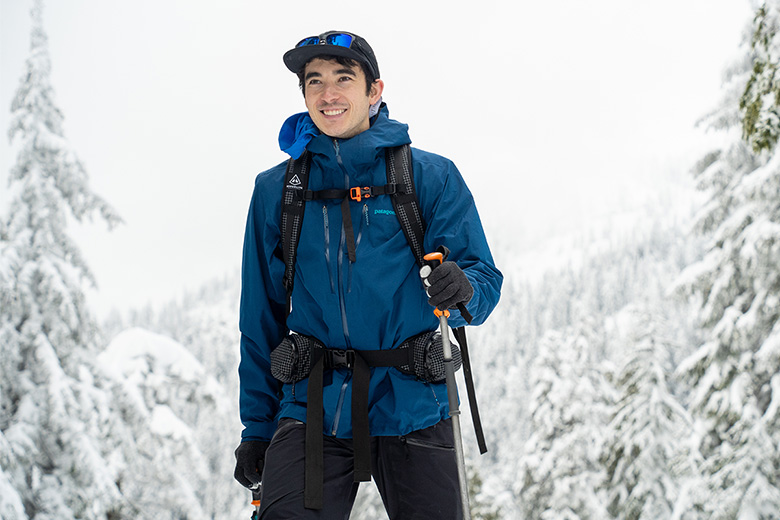
Price: $449
Weight: 1 lb. 2 oz. (men’s)
Waterproofing: 3L Gore-Tex ePE
What we like: Versatile and fully featured with a strong sustainability slant.
What we don’t: Not a standout in breathability; hood didn’t fit comfortably over our ski helmet.
See the Men's Patagonia Triolet See the Women's Patagonia Triolet
Patagonia is a consistent leader in the alpine apparel market, and their Triolet shell slots in as a burly and highly protective option at a reasonable price. The thick, 75-denier face fabric is excellent for use around sharp equipment, the 3-layer Gore-Tex construction—recently upgraded to their more sustainable ePE membrane—nicely fends off the elements, and Patagonia didn’t skimp on organization with five total pockets and ample adjustability. The Triolet is lacking in breathability for truly high-output uses, and I came away with a couple of feature-related complaints, but it nevertheless is a trustworthy and well-executed design for a wide range of winter activities, including resort and backcountry skiing. Below we outline our experiences with the Triolet. To see how it stacks up to the competition, check out our article on the best hardshell jackets.
Using a thick 75-denier (D) face fabric and 3-layer Gore-Tex ePE construction, the Patagonia Triolet Jacket feels nearly fortress-like in rough and rowdy weather. I initially had some concerns about the new membrane, which is more sustainably built than standard Gore-Tex, but I’m happy to report that the jacket has shrugged off everything I’ve thrown its way, from hiking through damp forests in British Columbia to ski touring above the Arctic Circle. In my experience, there’s no tangible difference in protection between the two membranes, and the upgrade in sustainability is a nice bonus (we provide an in-depth breakdown of the tech below). My only complaint is that the PFC-free durable water-repellent (DWR) coating along the exterior deteriorated quickly, only lasting a few days before starting to wet out. Importantly, no moisture has made its way through the shell, but it’s likely I’ll need to revive the treatment fairly frequently—by washing and drying the shell or applying a new coating—to avoid issues.

To be clear, the Triolet is overkill and fairly bulky for uses like summer backpacking, but the level of protection makes it a fantastic choice for the kinds of uses I subjected it to. In particular, the extended cut, helmet-compatible hood, glove-friendly cuffs, and tall collar (which reaches over the top of my lips when fully zipped) give it formidable performance in winter conditions. For those planning on using the Triolet as a dedicated ski shell, it’s worth noting that the jacket doesn’t include a powder skirt, but this shouldn’t be a dealbreaker for most (especially those who prefer bibs over snow pants).
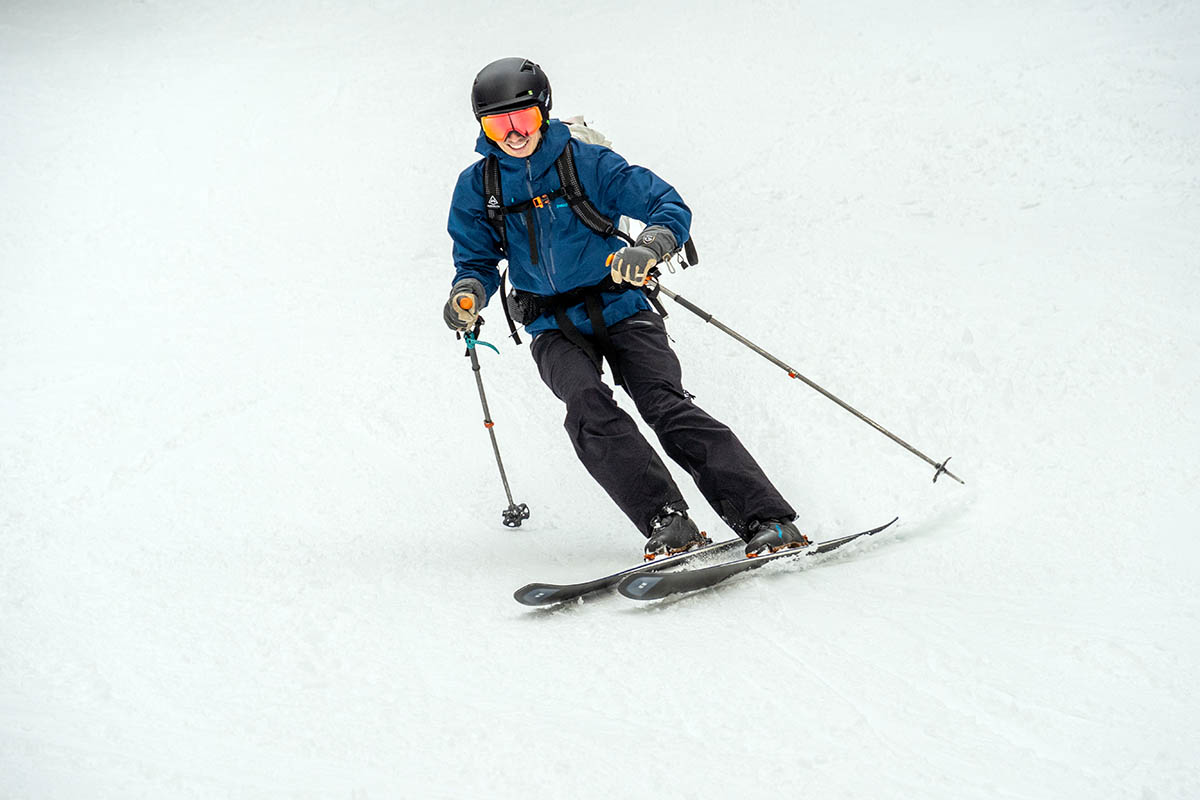
Unfortunately, the same tough construction that gives the Triolet its solid protection does have an impact on breathability. The thicker build and Gore-Tex membrane don’t vent especially well, and you can find marginally better breathers for high-output uses in alternatives like Arc’teryx’s Beta AR and Beta SL. To be fair, I’ve found the latest Triolet to be a modest upgrade from the past-generation model due to its lighter-weight ePE waterproof membrane and tricot backer, the latter of which helps draw moisture (i.e., sweat) away from the skin. But the difference isn’t substantial, and I still needed to open up the pit zips and unzip the front zipper (conditions permitting) when skinning uphill or hiking up steep slopes.
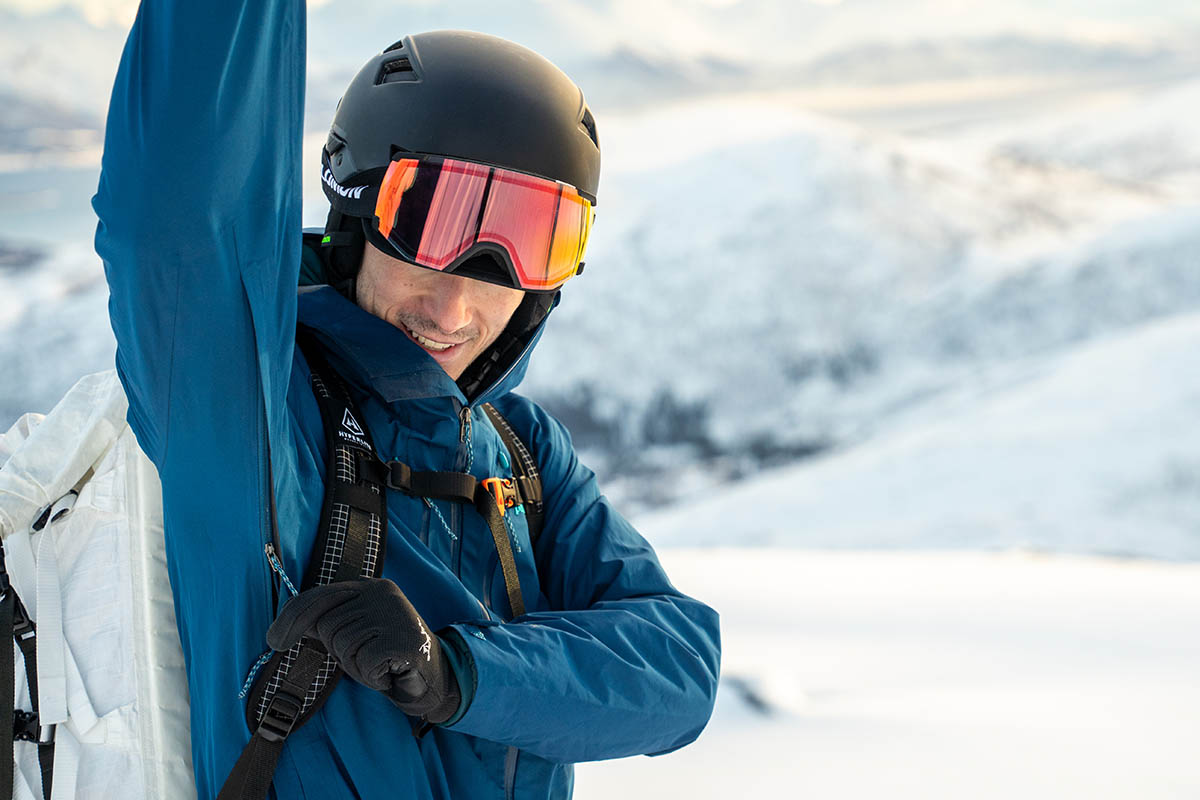
The latest version of the Triolet clocks in at a respectable 1 pound 2 ounces for the men’s version, shaving 1.4 ounces off the prior version. This reduction is likely due to the new ePE membrane, which is lighter and thinner than Gore’s standard ePTFE membrane. For comparison, Arc’teryx’s versatile Beta AR Jacket (which also uses Gore-Tex ePE) is slightly lighter at 1 pound 0.3 ounces but a little less ski-ready than the Triolet, while the similarly intentioned Rab Kangri GTX is nearly identical at 1 pound 2.5 ounces. In testing, the Triolet never felt burdensome to haul in my pack on long hikes or ski tours, and I was grateful to have such a sturdy and reliable shell when the skies opened up.

Importantly, you do get some great benefits for the added weight, such as the aforementioned bomber protection and a very feature-rich build (more on this below). Those focused on moving fast and light or summer and shoulder-season users who don’t need all the extras will be better off with a lighter option, but the Triolet nevertheless is a decent pick for true 4-season use. And on the bright side, packability is surprisingly good: Rolled into its hood and cinched tight, it’s about the size of a 1-liter water bottle, which is nearly on par with lighter designs like the Beta AR.
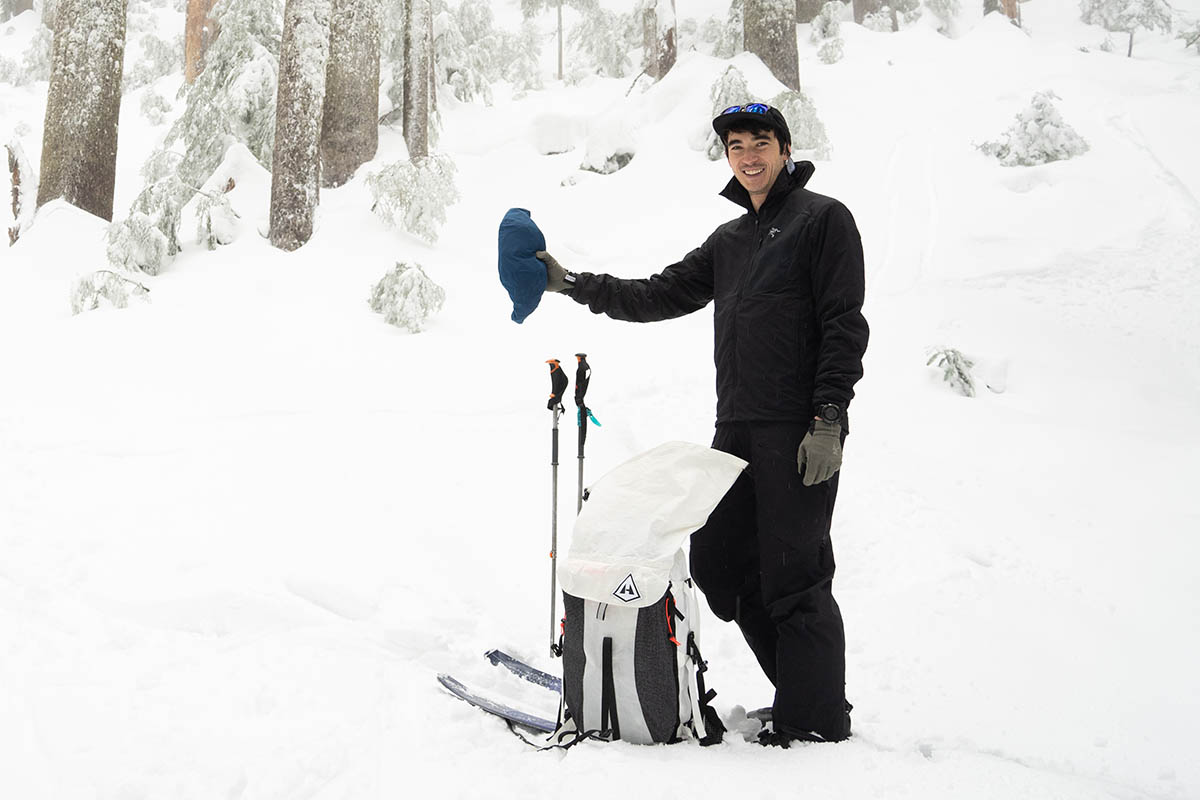
One complaint about the past-generation Triolet was its fairly stiff and bulky feel, but the latest version is a nice step up in the comfort department. One reason is the new ePE membrane, which is noticeably more supper than standard Gore-Tex and less noisy to boot. Patagonia also tacked on a tricot backer along the interior, which is great for both next-to-skin comfort and wicking sweat during activity. Added up, the Triolet strikes me as one of the more comfortable Gore-Tex shells on the market and a sizable upgrade from those that use crinkly (but more hardwearing) Gore-Tex Pro.
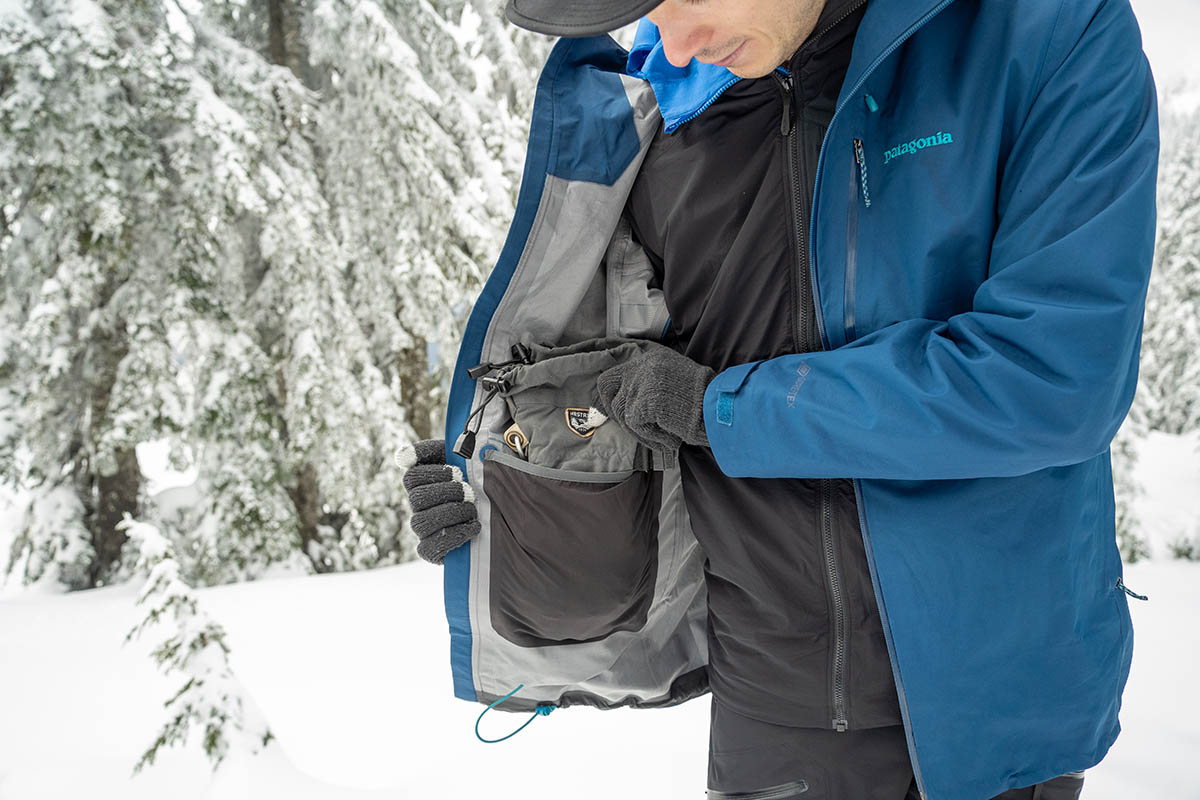
All that said, the Triolet wouldn’t be my first choice for wearing casually. My biggest complaint has to do with the excess fabric around the arms and torso, which allows for unrestricted mobility but gives the jacket a fairly unwieldy and oversized feel. Even though I have long arms, I found the sleeve length to be particularly excessive for around-town use, although the flip side is excellent coverage for skiing.
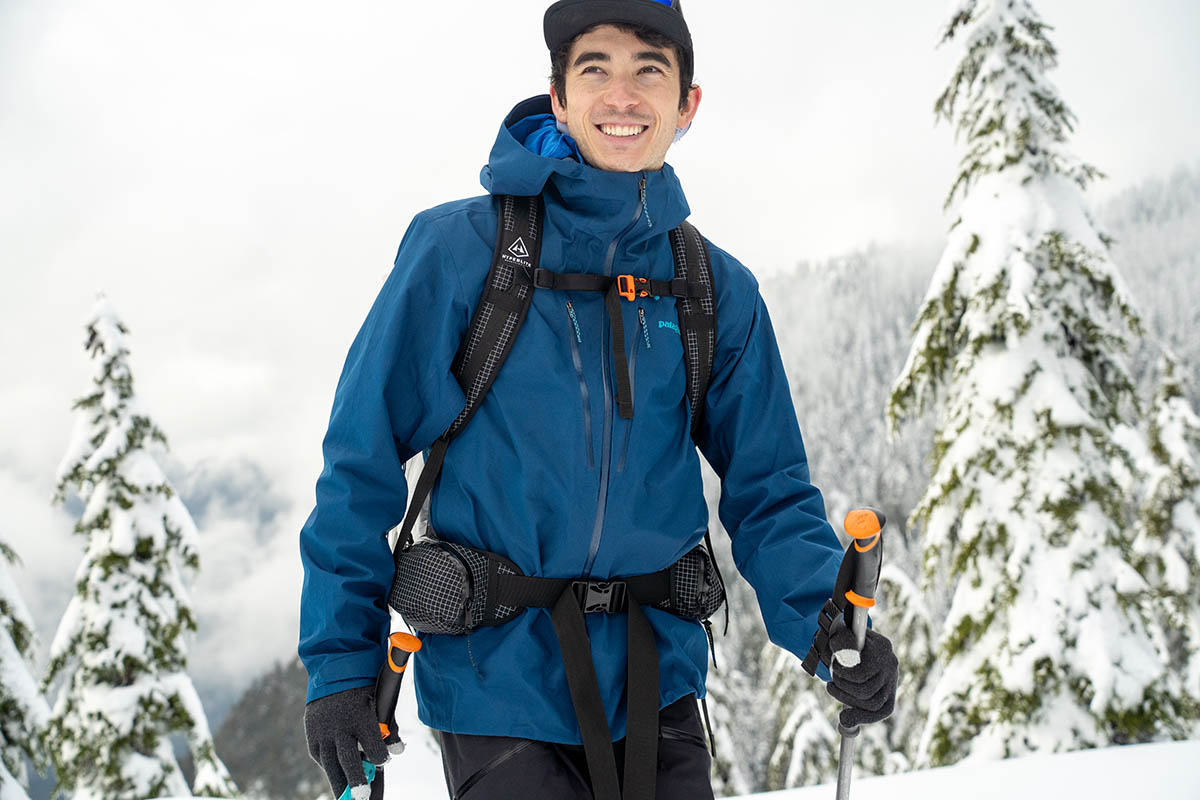
As expected with the tough build and Patagonia’s extensive experience in alpine gear, the Triolet Jacket is a hardwearing and long-lasting piece. Everything has a solid feel to it: The 75D face fabric is burly and confidence-inspiring even around sharp gear and ski equipment (many hardshells utilize 50D or lower), the exposed zippers are highly water-resistant and slide smoothly, and the tricot backer adds a nice dose of coziness. My only complaint—and it’s a small one—is that the hem drawcords are a little finicky and difficult to manipulate, especially with gloves on. But all in all, I’ve been largely impressed by the Triolet despite logging over 50 days of testing last fall and winter. And by Patagonia standards, the price strikes me as pretty competitive at just under $450. There are some signs of keeping costs in check—the pit zips and hand pockets use fabric flaps for protection rather than pricier coated zippers, for instance—but it’s a good price for a high-quality and well-built shell.
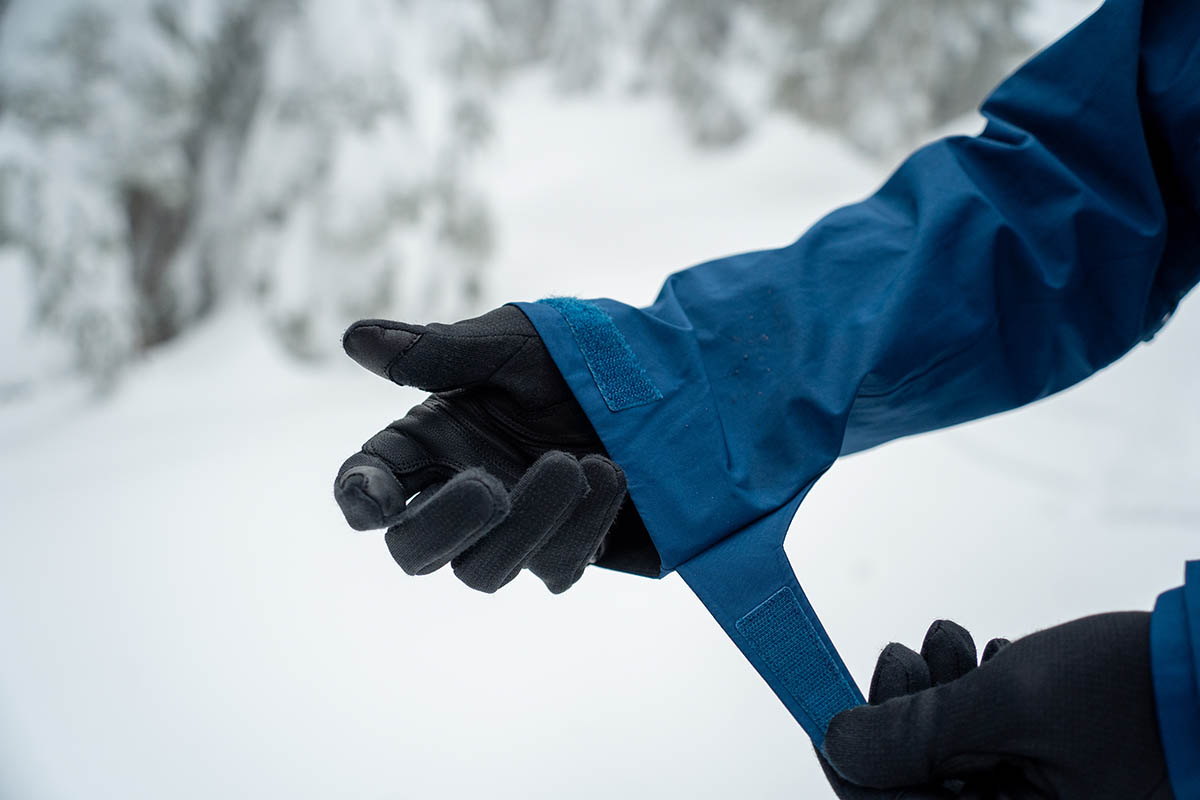
All things considered, the Triolet is a pretty feature-rich hardshell jacket. For starters, you get dual cinches at the waist (the cord is fed into the hand pockets), Velcro adjustments at the cuffs, two-way pit zips for dumping heat, and a Recco reflector to help with rescue efforts in an avalanche scenario. Additionally, you’re not low on options for distributing gear, with dual chest pockets, an interior mesh dump pocket, and two hand pockets. The interior pocket in particular is a real highlight: It’s a great size for goggles, gloves, or even a pair of climbing skins. And I frequently stashed snacks and a radio in the chest pockets, which allowed for quick access when wearing a pack. Finally, the hood features a large real pull cord and dual adjusters at the front, along with a laminated visor and stiff brim for deflecting moisture.
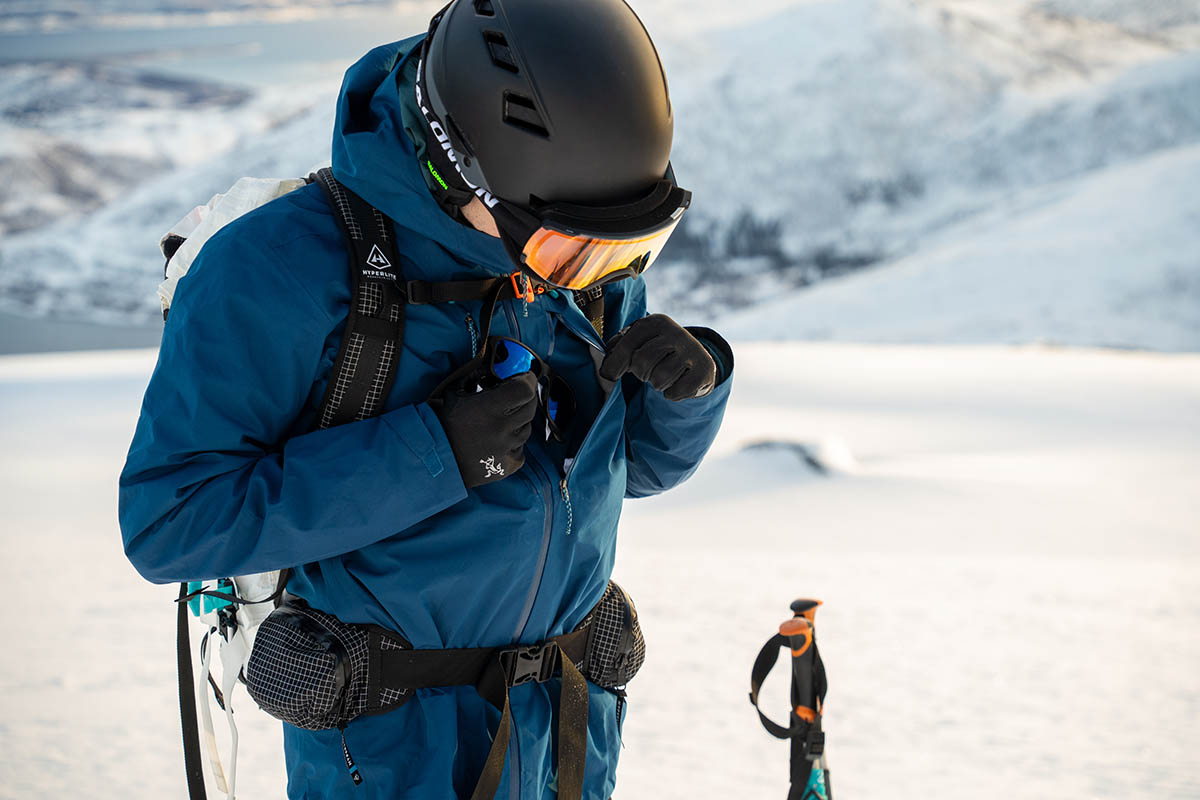
After extensive testing, I did come away with some complaints about a couple of the features. First, the hand pockets are placed a few inches farther back than I’m used to, making it difficult for me to reach inside to warm my hand or stash my climbing skins when wearing a backpack. I also found the hood to be prohibitively snug over a ski helmet, resulting in a noticeable amount of side-to-side restriction (it was fine with a lower-profile climbing helmet). Finally, Patagonia could have shifted one of the chest pockets to the interior for another layer of protection when storing electronics. But overall, I think Patagonia made smart choices with the feature set, and my issues with the hood likely won’t hold true for everyone.
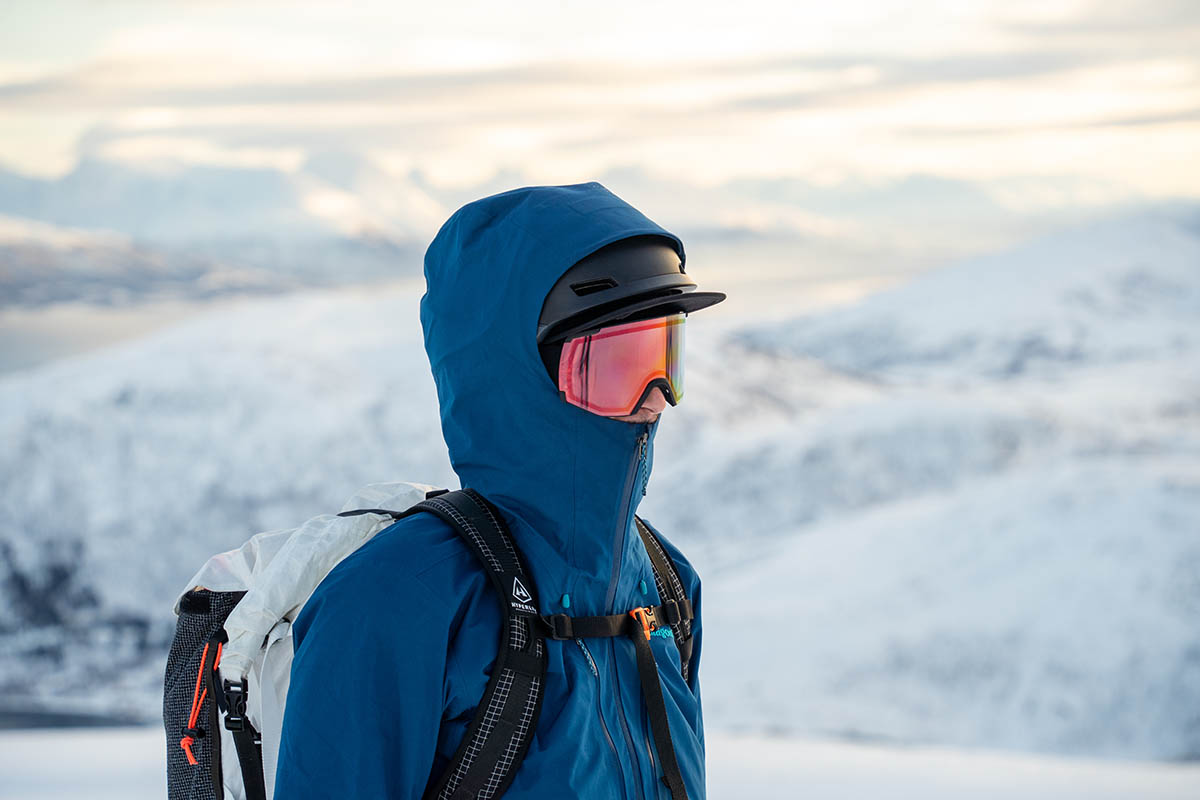
Patagonia dubs the Triolet Jacket a “regular” fit, meaning it’s meant to allow room for layering underneath without feeling overly bulky. I’m often in between sizes due to my tall and slim stature (for reference, I’m 6 ft. tall and 160 lb.) and went with a size medium, which ended up being spot-on. There was enough room for me to layer generously underneath, but not so much that I was swimming in the shell. It did feel pretty loose with just a baselayer underneath, but overall, I found the Triolet’s fit to be highly versatile and in line with its do-it-all intentions.
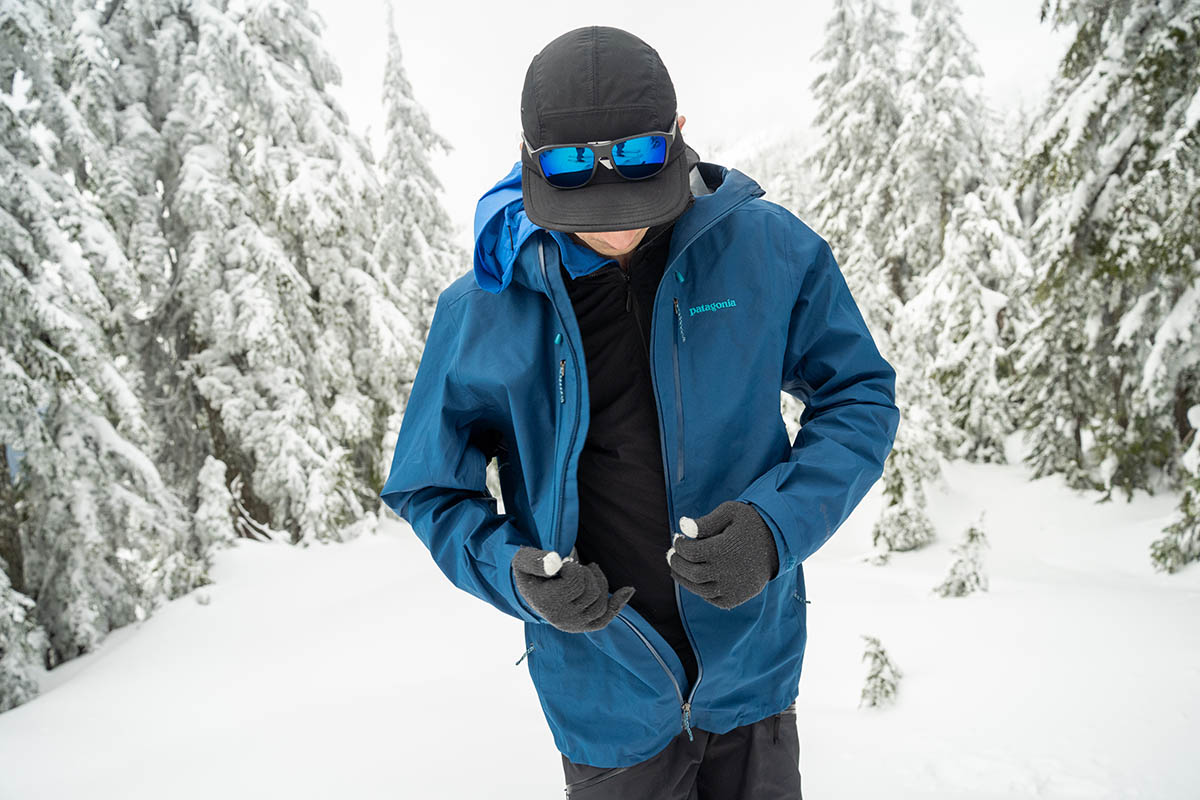
Patagonia is an industry leader in sustainable practices, and that focus comes across clearly in the Triolet. First, the shell is made from 100%-recycled polyester, and the entire jacket is bluesign-approved, meaning that all materials used are safe for the environment, workers, and consumers. The Triolet is also made in a Fair Trade Certified factory, indicating that Patagonia put extra money into production to ensure workers are being compensated fairly and have access to resources and community-funded initiatives like healthcare and childcare programs (you can read more about Fair Trade here). Finally, the jacket’s DWR finish and Gore-Tex membrane are made without PFAS, which we break down further below.
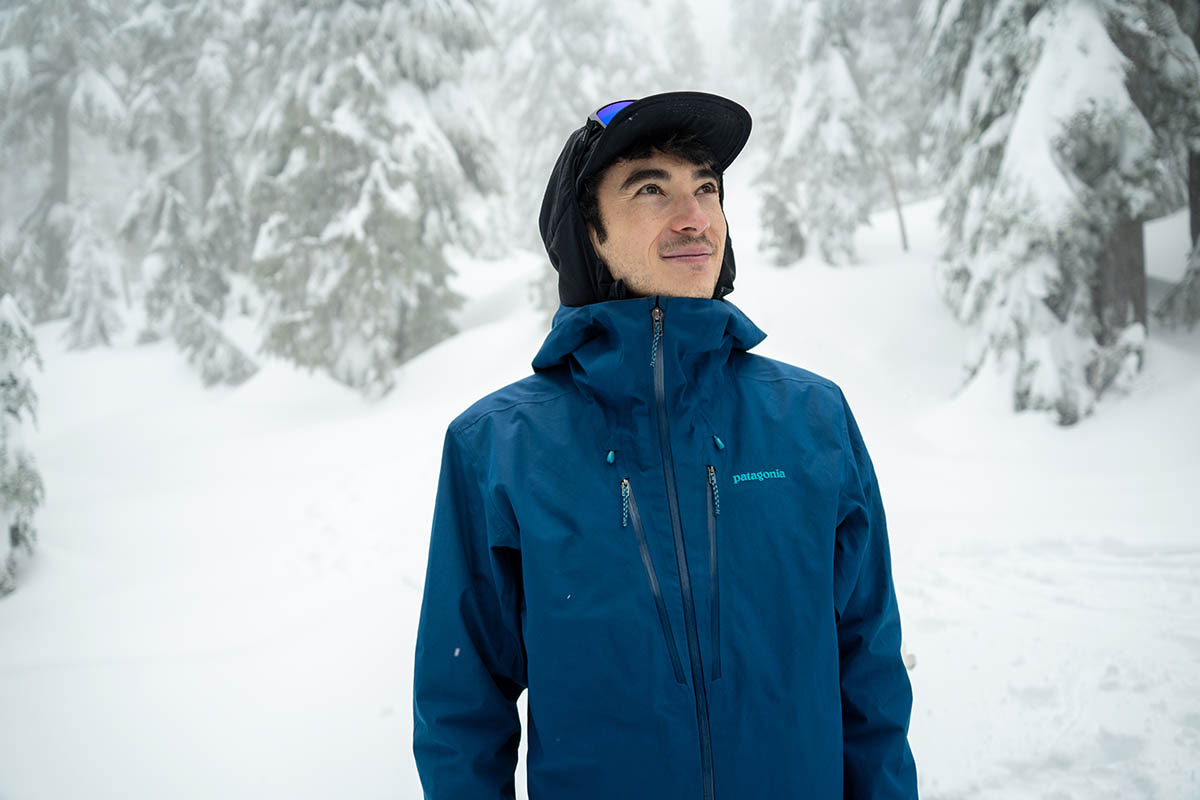
We referenced Gore’s latest ePE membrane several times throughout this review, which is an eco-friendlier alternative to their standard waterproof technology. Traditionally, Gore-Tex jackets have used membranes made from expanded polytetrafluoroethylene (ePTFE), a carbon-based material that’s incredibly hydrophobic while still allowing air to pass through. However, these membranes contain perfluorinated chemicals (commonly known as PFCs and PFAS), which are released into the environment during production and are known to be harmful to human health. They also don’t break down over time, earning them the nickname “forever chemicals.”
To solve this, Gore-Tex partnered with several leading outdoor brands to create a new waterproof membrane out of expanded polyethylene (ePE for short). Though still carbon-based, Gore-Tex ePE is free from harmful PFAS, and the membrane is both lighter and thinner, requiring fewer materials—thus, fewer pollutants—to produce. Some concerns have circulated about the new technology being a step down in protection from traditional Gore-Tex, but our initial impressions have been positive: The ePE membrane performs very similarly to its ePTFE predecessor. Plus, we’re always happy to get behind the push for more sustainable practices in the outdoor industry—even if it means sacrificing a little performance in the name of saving the planet.
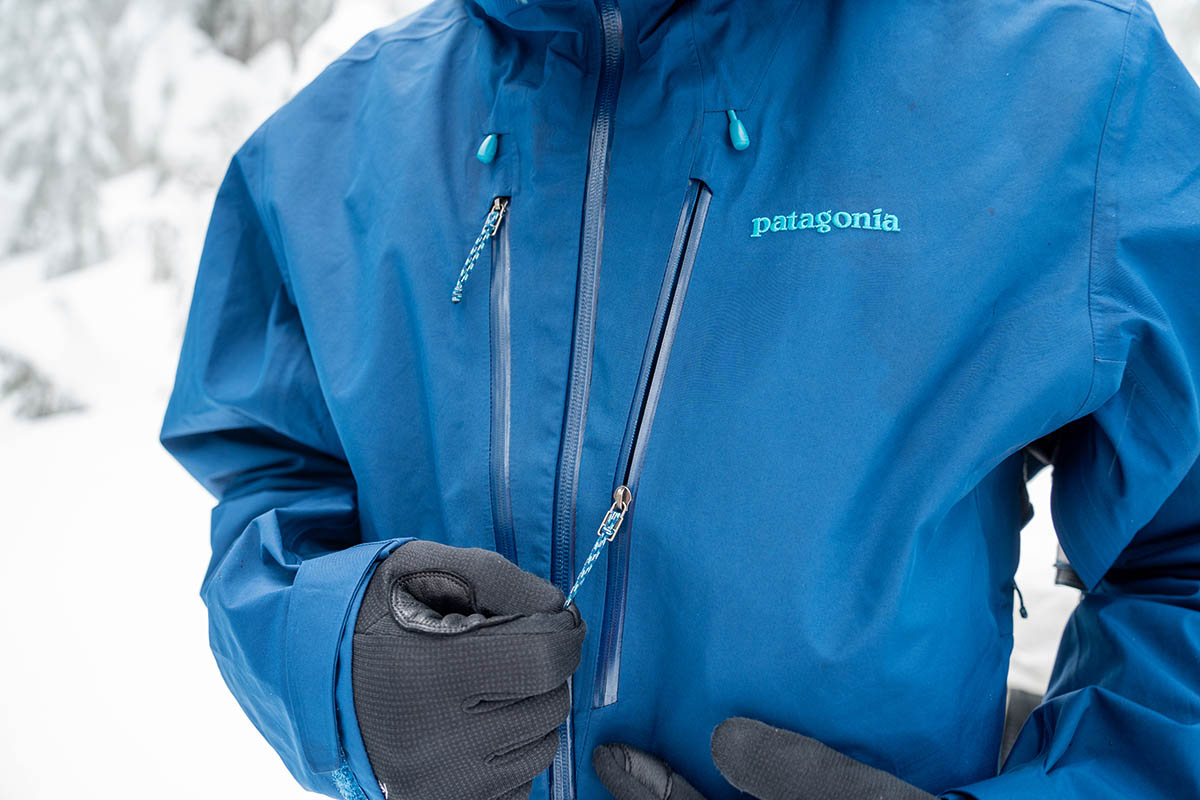
We put the men’s Triolet Jacket through its paces for this review, and Patagonia also offers a women’s-specific version and pant variations. The women’s Triolet Jacket costs the same as the men’s model at $449 and boasts an identical build and feature set, but it’s a little lighter at 1 pound, 1.6 ounces, and is sold in different colorways. To complete your kit, the Triolet Pants retail for $399 and use the same 3-layer Gore-Tex ePE construction for fending off inclement weather.
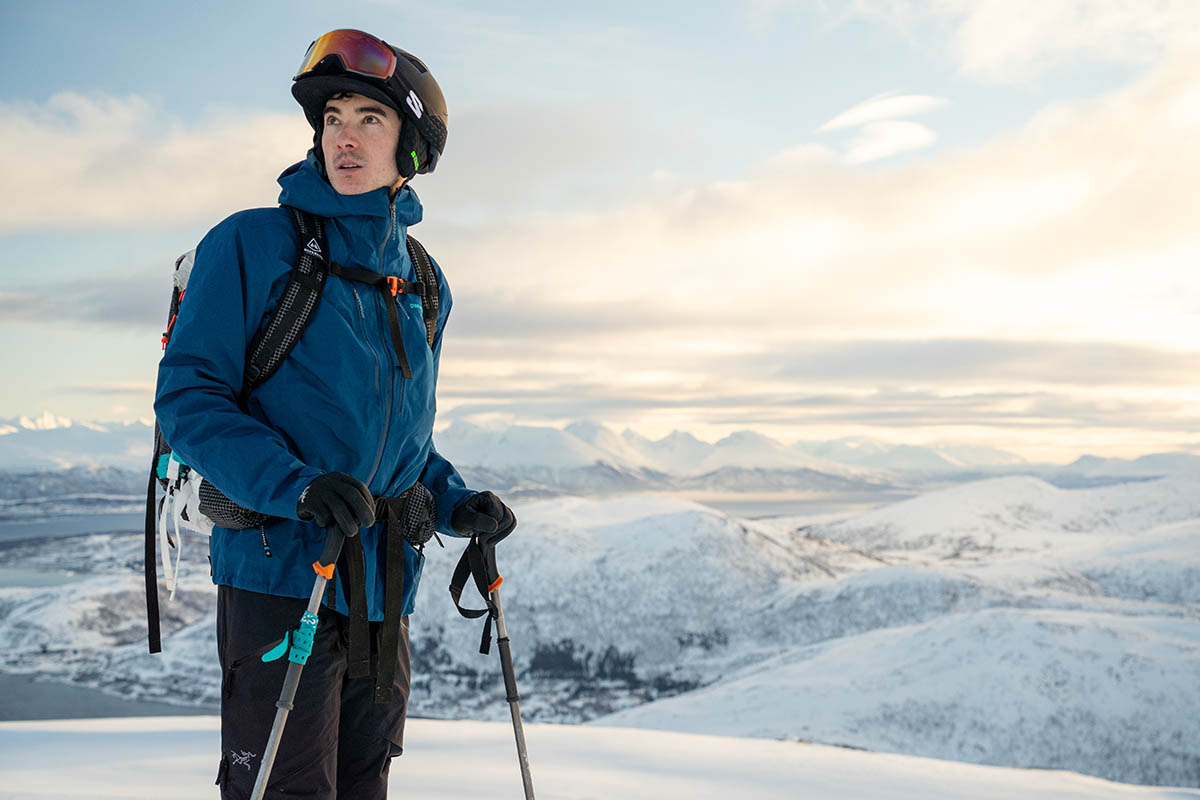
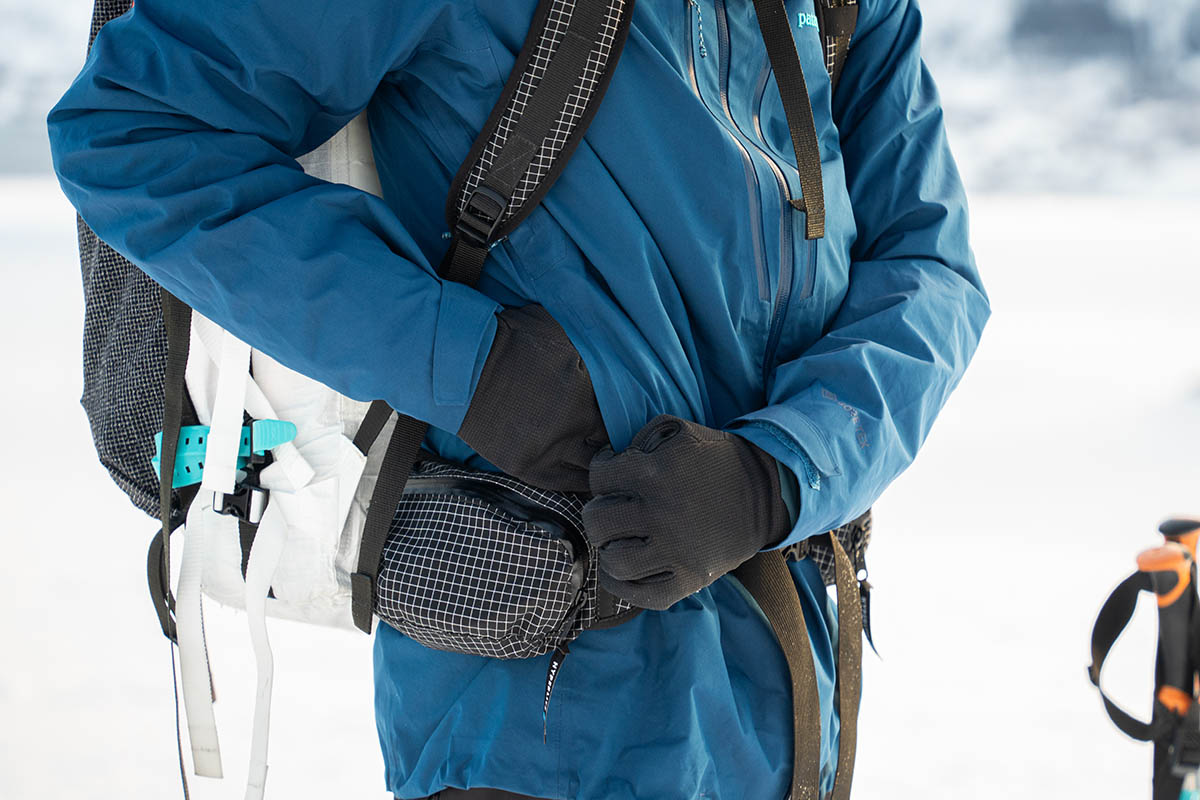
| Jacket | Price | Weight | Waterproofing | Denier | Pit Zips | Pockets |
|---|---|---|---|---|---|---|
| Patagonia Triolet Jacket | $449 | 1 lb. 2.0 oz. | 3L Gore-Tex ePE | 75D | Yes | 5 |
| Arc’teryx Beta SL Jacket | $500 | 12.0 oz. | 3L Gore-Tex ePE | 40D x 70D | Yes | 3 |
| Arc’teryx Beta AR Jacket | $600 | 1 lb. 0.3 oz. | 3L Gore-Tex Pro | 40D & 80D | Yes | 3 |
| Patagonia Super Free Alpine | $599 | 14.8 oz. | 3L Gore-Tex ePE | 40D | Yes | 3 |
| Rab Kangri GTX | $425 | 1 lb. 2.5 oz. | 3L Gore-Tex | 70D | Yes | 3 |
Patagonia’s Triolet stands out in the hardshell jacket market for its proven Gore-Tex waterproofing, burly build, and competitive feature set. For around $50 more, we also like Arc’teryx’s Beta SL (short for “superlight”). Right off the bat, we’ll note that the Beta SL is considerably less hardwearing with a thinner 40D by 70D face fabric, has a shorter cut that sacrifices some protection, and only comes with three total pockets. The main benefits are a significantly lower weight (12 oz.) and more athletic cut, resulting in a more streamlined look and feel. In the end, we’d break it down as follows: The Beta is our preferred option for traveling fast and light in summer and shoulder-season conditions, but the Triolet is the more purpose-built piece for spending time in the snow.
Next up is another design within the Beta family: the Arc’teryx Beta AR (“all round”). This jacket represents a step up in most respects, starting with a more premium, breathable, and hardwearing Gore-Tex Pro construction, which allows the Beta AR to be lighter (1 lb. 0.3 oz.) without compromising on toughness or protection. You also get hipbelt- and harness-friendly hand pockets, thick 80D reinforcements in high-wear areas (the rest of the shell is 40D), and premium touches like Arc’teryx’s streamlined RS zipper sliders that eliminate the need for “garages” at the top for sealing out moisture. The Triolet has a longer cut, making it the better-dedicated ski piece at a considerable $150 less, but the Beta AR is the more capable do-everything hardshell (for more, see our in-depth Beta AR review).
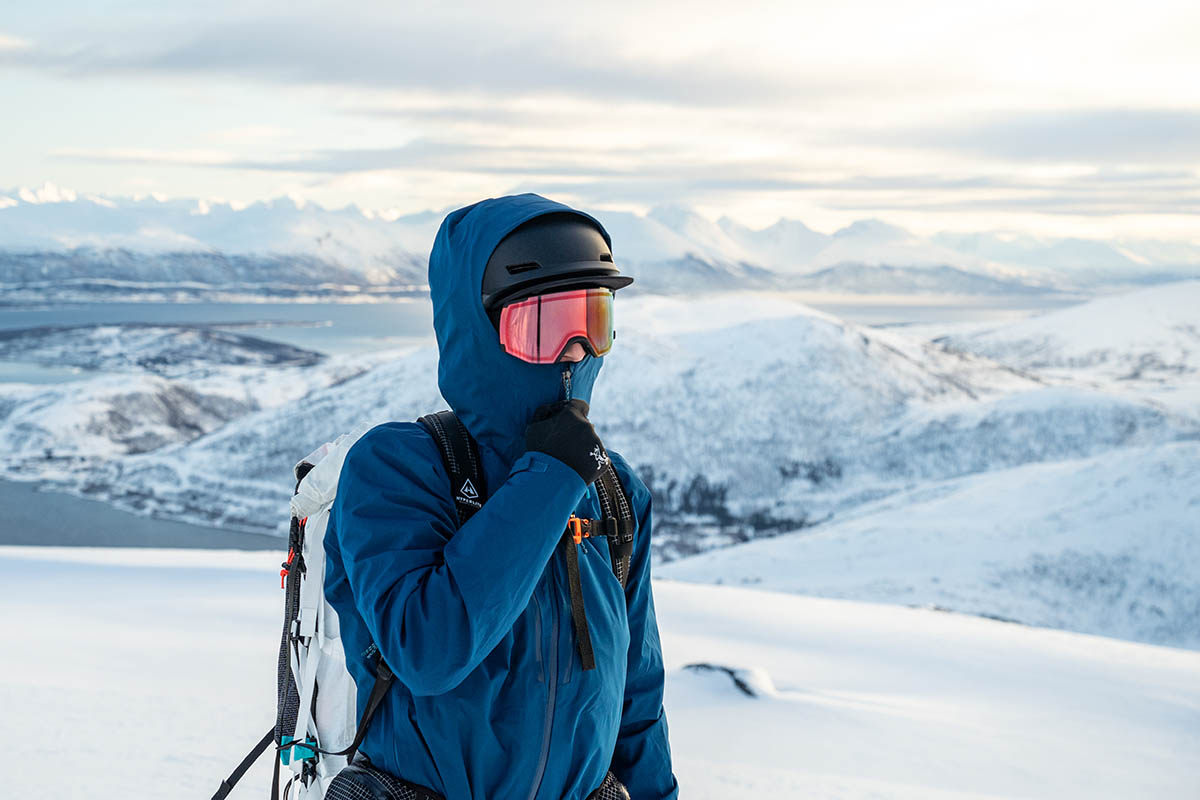
Outside of Arc’teryx’s lineup, Patagonia offers a competitive alternative to the Triolet in their Super Free Alpine Jacket. As its name suggests, the Super Free Alpine is purpose-built for harsh mountain environments with a trustworthy 3-layer Gore-Tex ePE construction, a lightly insulated and helmet-compatible hood, harness-friendly hand pockets, two-way pit zips, and a drop-tail hem with hip cutouts to increase mobility when high-stepping. Impressively, Patagonia managed to pack all that in while keeping weight competitively low, with the Super Free Alpine clocking in around 3 ounces lighter than the Triolet. The biggest compromise is durability: The Super Free Alpine uses a relatively thin, 40D face fabric that’s far less confidence-inspiring than the Triolet’s 75D build. Combined with the steep $599 price tag, the Triolet is far and away the better all-rounder. But for alpinists looking to keep weight and bulk to a minimum, the Super Free Alpine is an undeniably high-performance option.
Last but not least is Rab’s Kangri GTX, which shares the Triolet’s all-rounder intentions in a similarly well-executed package. For around $25 less than the Patagonia, the Kangri is similarly weather-worthy with a 3-layer Gore-Tex membrane and burly, 70D nylon shell. The two also line up closely in weight, with the Rab checking in just 0.5 ounces heavier. And like the Triolet, the Kangri leaves little to be desired from a features standpoint, with a two-way main zipper (which the Triolet lacks), large and harness-compatible hand pockets, generously sized pit zips, and adjustability at the hood, hem, and cuffs. Both jackets also have long cuts that make them well-suited for winter activities like skiing and snowshoeing. In the end, it’s hard to deny the brand cachet and quality fit and finish you get from Patagonia, but the Kangri is a seriously well-built and capable 4-season hardshell at a lower price.